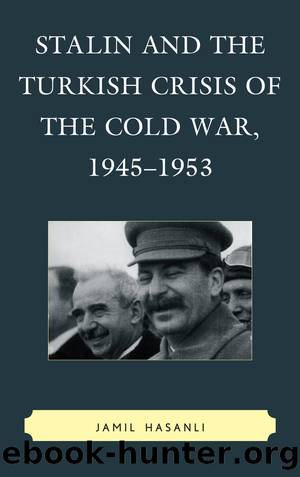Stalin and the Turkish Crisis of the Cold War, 1945-1953 by Jamil Hasanli

Author:Jamil Hasanli [Hasanli, Jamil]
Language: eng
Format: epub
Publisher: Lexington Books
Published: 2011-06-14T16:00:00+00:00
Chapter Five
Soviet Plans on the Straits and Their Failure
In summer 1946, Turkey was the scene of heated political passions. Pressured by the Soviets and experiencing troubles of the emerging Cold War on the one hand, Turkey was preparing for elections to be held on a multi-party basis on the other. Under the influence of orientation toward a Western system of values, Turkish leaders introduced elements of western democracy to their domestic policy. Leaving the fundamental principles of the state system intact, Turkey applied a multi-party election system. Press, radio and other propaganda bodies started active work for the July Parliamentary elections. The Soviet Embassy in Ankara reported in April–May 1946 that from the second half of April the Turkish press focused on internal policy and the struggle between the People’s Republican and Democratic parties.1
The Soviet Union closely watched the Turkish developments in an attempt to change this “undesirable” government into a “friendly” one. The Soviet’s shift to a “wait-and-see” policy, the lull after the Potsdam conference, lack of new proposals on the Straits, and the fading of the issue of eastern provinces—all these came from the new political situation in Turkey. Therefore, the Soviet diplomatic service in Turkey and Soviet Foreign Ministry’s Near Eastern Department closely watched the developing democratic processes, opposition activities, etc. On March 9, 1945, First Secretary of the Soviet Embassy S. Mikhailov sent a list of the Turkish Foreign Ministry top officials to the Foreign Ministry of the USSR.2
A week before the victory over fascist Germany, the Soviet Foreign Ministry “reviewed” the current government of Turkey and prepared personal reports on Turkish Cabinet members. These included Saracogˇlu, Saka, Ali Rıza Artunkul, Hilmi Uran, F. Sermen, Ali Rıza Türel, C. S. Sizen, S. Day, S¸evket Ras¸it Hatipogˇlu, Nurullah Esat Sümer, S. Konuk, Fuad Hayri Ürgüplü, Ali Fuat Cebesoy, Hasan Ali Yücel and others. For example, the report on Saracogˇlu, who led the Turkish government from July 1942, was notable for its severe nature: he was characterized as an “undesirable” politician for the Soviets. The same was true of Foreign Minister H. Saka. It was stressed that Saka was a well-known expert on the Balkans, participant of some Balkan conferences, and former head of the Economic Council of the Balkan Entente. At the same time, the report pointed out that Saka did not enjoy popularity in diplomatic circles, that he took his post due to I˙nönü’s patronage and that his political views were not different from those of Prime Minister Saracogˇlu.3
Analyzing postwar changes, political circles of Turkey realized the necessity of transition to the multi-party system and implementation of democratic reforms. In April 1945, head of the Turkish delegation to the San Francisco conference, H. Saka provided information about forthcoming democratic changes in the country and permitted the activities of various political movements. A few days later, President I˙nönü declared that political restrictions of the war period would be lifted and democratic principles applied. It was the signing of the UN Declaration by Turkey and
Download
This site does not store any files on its server. We only index and link to content provided by other sites. Please contact the content providers to delete copyright contents if any and email us, we'll remove relevant links or contents immediately.
| Africa | Americas |
| Arctic & Antarctica | Asia |
| Australia & Oceania | Europe |
| Middle East | Russia |
| United States | World |
| Ancient Civilizations | Military |
| Historical Study & Educational Resources |
The Sympathizer by Viet Thanh Nguyen(4096)
The Rape of Nanking by Iris Chang(4024)
World without end by Ken Follett(3347)
Ants Among Elephants by Sujatha Gidla(3282)
Blood and Sand by Alex Von Tunzelmann(3060)
Japanese Design by Patricia J. Graham(3004)
City of Djinns: a year in Delhi by William Dalrymple(2436)
Foreign Devils on the Silk Road: The Search for the Lost Treasures of Central Asia by Peter Hopkirk(2389)
Inglorious Empire by Shashi Tharoor(2347)
The Queen of Nothing by Holly Black(2324)
In Order to Live: A North Korean Girl's Journey to Freedom by Yeonmi Park(2304)
India's Ancient Past by R.S. Sharma(2303)
Tokyo by Rob Goss(2294)
India's biggest cover-up by Dhar Anuj(2250)
Tokyo Geek's Guide: Manga, Anime, Gaming, Cosplay, Toys, Idols & More - The Ultimate Guide to Japan's Otaku Culture by Simone Gianni(2243)
The Great Game: On Secret Service in High Asia by Peter Hopkirk(2231)
Goodbye Madame Butterfly(2163)
Batik by Rudolf Smend(2009)
Living Silence in Burma by Christina Fink(1985)
